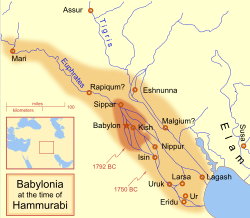First Babylonian Dynasty
| Paleo-Babylonian Empire | ||||||||||
| Paleo-Babylonian Empire | ||||||||||
|
||||||||||
|
The extent of the Paleo-Babylonian Empire at the start and end of Hammurabi of Babylon's reign, c. 1792 BCE — c. 1750 BCE
|
||||||||||
| Capital | Babylon | |||||||||
| Languages | Babylonian language | |||||||||
| Religion | Babylonian religion | |||||||||
| Government | Monarchy | |||||||||
| King | ||||||||||
| • | ca. 1830—1817 BC | Sumu-abum (first) | ||||||||
| • | ca. 1562—1531 BC | Samsu-Ditana (last) | ||||||||
| Historical era | Bronze Age | |||||||||
| • | Established | c. 1830 BCE | ||||||||
| • | Sack of Babylon | c. 1531 BCE | ||||||||
| • | Disestablished | c. 1531 BCE | ||||||||
|
||||||||||
| Today part of |
|
|||||||||
The chronology of the first dynasty of Babylonia is debated as there is a Babylonian King List A and a Babylonian King List B. In this chronology, the regnal years of List A are used due to their wide usage. The reigns in List B are longer, in general.
The short chronology:
The actual origins of the Dynasty are rather hard to pinpoint with great certainty simply because Babylon itself, due to a high water table, yields very few archaeological materials intact. Thus any evidence must come from surrounding regions and written records. Not much is known about the kings from Sumuabum through Sin-muballit other than the fact they were Amorites rather than indigenous Akkadians. What is known, however, is that they accumulated little land. When Hammurabi (also an Amorite) ascended the throne of Babylon, the empire only consisted of a few towns in the surrounding area: Dilbat, Sippar, Kish, and Borsippa. Once Hammurabi was king, his military victories gained land for the empire. However, Babylon remained but one of several important areas in Mesopotamia, along with Assyria, then ruled by Shamshi-Adad I, and Larsa, then ruled by Rim-Sin I.
In Hammurabi's thirtieth year as king, he really began to establish Babylon as the center of what would be a great empire. In that year, he conquered Larsa from Rim-Sin I, thus gaining control over the lucrative urban centers of Nippur, Ur, Uruk, and Isin. In essence, Hammurabi gained control over all of south Mesopotamia. The other formidable political power in the region in the 2nd millennium was Eshnunna, which Hammurabi succeeded in capturing in c. 1761. Babylon exploited Eshnunna's well-established commercial trade routes and the economic stability that came with them. It was not long before Hammurabi's army took Assyria (another economic powerhouse) and parts of the Zagros Mountains. In 1760, Hammurabi finally captured Mari, the final piece of the puzzle that gave him control over virtually all of the territory that made up Mesopotamia under the Third Dynasty of Ur in the 3rd millennium.
...
Wikipedia

